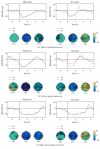Predicting Functional Recovery in Chronic Stroke Rehabilitation Using Event-Related Desynchronization-Synchronization during Robot-Assisted Movement
- PMID: 27057546
- PMCID: PMC4739000
- DOI: 10.1155/2016/7051340
Predicting Functional Recovery in Chronic Stroke Rehabilitation Using Event-Related Desynchronization-Synchronization during Robot-Assisted Movement
Abstract
Although rehabilitation robotics seems to be a promising therapy in the rehabilitation of the upper limb in stroke patients, consensus is still lacking on its additive effects. Therefore, there is a need for determining the possible success of robotic interventions on selected patients, which in turn determine the necessity for new investigating instruments supporting the treatment decision-making process and customization. The objective of the work presented in this preliminary study was to verify that fully robot assistance would not affect the physiological oscillatory cortical activity related to a functional movement in healthy subjects. Further, the clinical results following the robotic treatment of a chronic stroke patient, who positively reacted to the robotic intervention, were analyzed and discussed. First results show that there is no difference in EEG activation pattern between assisted and no-assisted movement in healthy subjects. Even more importantly, the patient's pretreatment EEG activation pattern in no-assisted movement was completely altered, while it recovered to a quasi-physiological one in robot-assisted movement. The functional improvement following treatment was large. Using pretreatment EEG recording during robot-assisted movement might be a valid approach to assess the potential ability of the patient for recovering.
Figures




References
-
- Prange G. B., Jannink M. J. A., Groothuis-Oudshoorn C. G. M., Hermens H. J., Ijzerman M. J. Systematic review of the effect of robot-aided therapy on recovery of the hemiparetic arm after stroke. Journal of Rehabilitation Research and Development. 2006;43(2):171–183. doi: 10.1682/JRRD.2005.04.0076. - DOI - PubMed
-
- Kwakkel G., van Wegen E. E., Meskers C. M. Invited commentary on comparison of robotics, functional electrical stimulation, and motor learning methods for treatment of persistent upper extremity dysfunction after stroke: a randomized controlled trial. Archives of Physical Medicine and Rehabilitation. 2015;96(6):991–993. doi: 10.1016/j.apmr.2015.02.004. - DOI - PubMed
MeSH terms
LinkOut - more resources
Full Text Sources
Other Literature Sources
Medical

